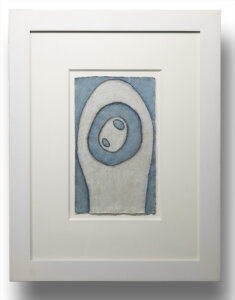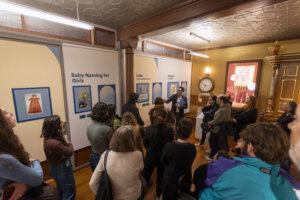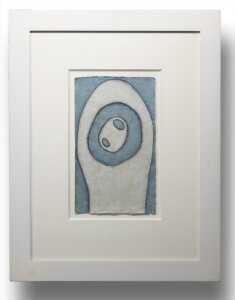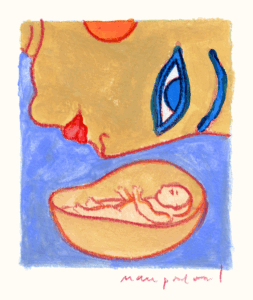Uncategorized
ChatGPT can write verse, but it is no more alive than the Golem of Prague
(JTA) — ChatGPT, an AI (artificial intelligence) chatbot with remarkable abilities to mimic human language, has been making big news. One stunt that’s gotten a lot of attention is ChatGPT’s alleged ability to write poetry. If true, this would mark a major advance. If an AI app can write real poetry, it has acquired a soul.
Have we crossed that threshold now with ChatGPT? The program is fun and swiftly generates remarkably lifelike responses to queries and prompts, in grammatically correct if somewhat dull and stuffy sentences. Still, the responses are often full of excellent information.
We’ve certainly made progress in building machines that think. The chess program Deep Blue can beat any grandmaster. Given a prompt like, “Draw me Donald Duck in the style of Rembrandt surfing on an ocean of macaroni” an art-generating AI like DALL-E can produce remarkable illustrations instantly. “Write me a sonnet about e-bicycles in the style of Shakespeare “— presto, ChatGPT can spit out a sonnet.
For many, the difference between these AI-generated products and the real deal is hard to discern — as it was for the congregants of the New York rabbi who delivered a sermon generated by AI this past Shabbat. If ChatGPT is writing poetry it has passed a most difficult version of the Turing test.
Alan Turing, the early computer scientist who helped crack the Nazis’ Enigma code in World War II, speculated on how to tell if a machine has acquired real intelligence: Can it fool a human being into believing it, too, is human? Imagine yourself exchanging texts with an unseen source hidden behind a screen. If you can’t tell whether you are conversing with a machine or a person, the computer has passed the Turing test.
But I’ve found a loophole. What if the human judge is devolving at the same rate that AI is advancing? Perhaps people are becoming more like computer programs as computer programs become more human. I often hear people say, “I am multitasking,” or “I need to recharge my batteries.” They are emulating machines and even a little proud of it. What if ChatGPT seems to be writing poetry because so many people have become so mechanical in their thinking they can’t recognize the poetry of life?
Out of the wounded vanity of a merely human poet, I asked ChatGPT to “write me a poem about kabbalah in the style of Rodger Kamenetz.” Here are the first four lines:
Kabbalah, the ancient wisdom of the Jews
Enshrined in symbols, stories, and the Tree
Of Life, a map to guide us through our dues
And find the spark of divinity within
To those who know and love poetry this isn’t poetry. It is verse — language written in a rough iambic pentameter that has zero felicity.
The verse offers some good clichés about kabbalah because ChatGPT draws instantly from the whole internet. But ChatGPT has no idea what it is saying. It doesn’t care, or have access, to the kind of truths found in poetry. It just cobbles words and phrases together in a plausible way. Since I asked for a poem, it pours the content into a metrical form. But that doesn’t make it beautiful.
In skillful verse, line breaks and end rhymes create variety and emphasis. But what emphasis is served by rhyming “Jews” and “dues”? What does “dues” even mean in this context — unless it’s a reminder to pay your synagogue dues?
Judging from the response to ChatGPT’s verse, many do think it writes poetry. But that’s where the loophole comes in. The Turing test depends on a human judge. For a judge who has never spent time dwelling on what is beautiful in poetry, ChatGPT has passed the test. But that does not prove that ChatGPT is genuinely creative. It just proves that many people have little interest in poetry, and do not value primary imagination. If I can’t tell whether I am talking to a program or a person, maybe the problem is with me. I pity anyone who can’t distinguish verse written by a bot and a poem by Alicia Ostriker or Gerald Stern.
ChatGPT is no more alive than the legendary golem of Prague.
It is said that the Maharal — the great Rabbi Judah Loew of 16th-century Prague — fashioned a magical creature of river mud in order to (what else?) save the Jews. Using permutations of the names of God, the Maharal brought the golem to life by writing “emet” on the creature’s forehead — Hebrew for “truth.”
The legend is rooted in Talmudic discussions of the mystical Book of Formation (Sefer Yetzirah), and further back to Genesis 2:7 which describes a second version of Adam’s creation:
Then the LORD God formed man of the dust of the ground, and breathed into his nostrils the breath of life; and man became a living soul.
Here we see the original transition from matter to life, from a mere golem — a heap of dirt — to an “adam,” a human being. And according to the 2nd-century translator Onkelos, what marks that transition is the human’s ability to speak poetic language.
When Onkelos translates Genesis 2:7, he renders the Hebrew “nefesh haya” — living soul — as the Aramaic “ruach m’mamila” — a speaking spirit. Poetry is that spirit speaking. Poetry is the utterance of a living soul. And poetry inscribes truth, not on a forehead of mud, but on the human heart.
ChatGPT cannot tell — and doesn’t care — whether what it is writing is true or beautiful. But in the best poetry we hear that strong “speaking spirit” — what Wallace Stevens called “the voice that is great within us.” Poetry rings true — and makes us more beautifully human.
—
The post ChatGPT can write verse, but it is no more alive than the Golem of Prague appeared first on Jewish Telegraphic Agency.
Uncategorized
Trump’s new White House ballroom architect is a Jewish immigrant who has advocated for refugees
(JTA) — After parting ways with the first architect hired to carry out his vision for the White House’s East Wing, President Donald Trump has picked a replacement — turning to a firm run by prominent Jewish architect who once called on Trump to keep the country’s doors open to refugees and immigrants.
Shalom Baranes was born soon after his parents fled Libya amid antisemitic sentiment there, coming to the United States as a child with the help of the Hebrew Immigrant Aid Society, now known as HIAS. He rose to prominence as an architect in Washington, D.C., where he has designed both private and government buildings, including the Pentagon, that trend toward the modern.
The White House confirmed on Friday that it had chosen his firm, Shalom Baranes Associates, to continue the East Wing project, centered around the ballroom that Trump wishes to construct. Trump clashed with the first architect on the job over the ballroom’s size.
“Shalom is an accomplished architect whose work has shaped the architectural identity of our nation’s capital for decades, and his experience will be a great asset to the completion of this project,” a White House spokesman, Davis Ingle, said in a statement on Friday.
The firm did not immediately publicly confirm its attachment to the project, and Baranes did not reply to a Jewish Telegraphic Agency request for comment.
Baranes’ selection stands out in an administration that has typically favored partisan and ideological loyalists. Baranes is a repeated donor to Democratic candidates who has openly advocated against one of Trump’s signature policies, his efforts to limit refugee admissions.
In 2017, two months into Trump’s first term, Baranes penned an op-ed for the Washington Post about the new president’s travel ban. Trump had declared a ban on migrants from seven mostly Muslim countries and refugees from around the world soon after taking office, igniting wide opposition including from Jewish groups.
“The anti-immigrant sentiment I feel today is nothing new to me,” he wrote. “When my Jewish parents arrived in the United States just a few years after fleeing persecution in an Arab regime, it was as difficult for them to be accepted here as it is for Muslims now.”
Baranes laid out his criticism gingerly while saying he hoped the travel ban would be short-lived.
“As I watch the news and see families struggling to leave their countries and escape tyranny, I wonder who among them will make it to our shores and become part of the next generation of researchers, teachers, inventors, real estate developers and, yes, architects,” he wrote. “My hope is that the Trump administration will take actions to ensure that the travel ban is indeed temporary, so that good, hard-working individuals fleeing tyranny can find a new home as I did — and that each of them will be given the same opportunity to help build this great nation that I had.”
Among the Jewish groups to lobby against Trump’s travel ban was HIAS, the organization that had helped Baranes and his family come to the United States. HIAS declined to comment on his selection as White House architect but said through a spokesperson that the organization was working to respond to Trump’s crackdown on refugees, which the president renewed last week after an Afghan refugee shot and killed a member of the National Guard in Washington.
To those who are familiar with Baranes’ style, he is a surprising pick for more than just because of his personal politics. His designs typically trend toward the modern, not the gilded classical style that Trump favors. He also has said he prefers to think carefully before tackling a project — an impossibility when it comes to the White House ballroom, which is already mid-construction.
“You have to wonder why he would risk a stellar career and near pristine reputation for a project that could possibly end up in disaster. He could be publicly fired and castigated by the developer-in-chief or ostracized among his colleagues and clients,” wrote Douglas Freuhling, the editor in chief of the Washington Business Journal, on Friday.
But Fruehling noted that a successful build at the White House — one that balances Trump’s tastes with the gravitas of the White House — would be a defining capstone for any architect’s career. “He may just be the perfect architect for the job. For his sake, I hope it turns out that way,” he wrote of Baranes.
Baranes’ portfolio includes multiple synagogue renovations. He donated his services to restore the interior of Sixth & I, the Jewish center in downtown Washington, D.C., when it was reconstructed just over two decades ago.
The post Trump’s new White House ballroom architect is a Jewish immigrant who has advocated for refugees appeared first on The Forward.
Uncategorized
It’s time to reconsider what we know about Jewish birthing rituals

For all living things, birth is our introduction to the world. So it’s a fitting theme for the first exhibit in the Museum at Eldridge Street’s new initiative, “Opening Doors to Intercultural Understanding.”
The multiyear project is centered around three themes: sacred space, sacred community and sacred time. First Light is inspired by sacred time, which focuses on lifecycle events and holidays in the Jewish calendar. The museum staff worked with curator Warren Klein, the director and curator at Herbert & Eileen Bernard Museum of Judaica, to come up with the idea for an exhibit on birth.
“Of course, there’s a universal resonance there,” Amanda Gordon, the museum’s director of public engagement, said. “But really First Light is all about examining Jewish birth traditions and different observance practices, how they’ve evolved, but also different kinds of aesthetic craftsmanship ideas.”
Visitors are first greeted with contemporary paintings from artists Tobi Kahn and Mark Podwal that depict the significance of birth both personally and biblically. Kahn’s abstract painting evokes one of his children’s sonograms through its textured exploration of rounded shapes. This is juxtaposed with Podwal’s depiction of Pharaoh’s daughter finding Moses in the Nile, using a classic Egyptian style to depict the female face looming over baby Moses, almost protectively. Further along in the exhibit are older examples of birth-related rituals both in art and in historic objects.
“These rotating exhibitions,” Gordon said. “They give us a chance to showcase not only cultures outside of Ashkenazi Jewish culture, but also contemporary work. So to have, you know, Tobi’s work and Mark Podwal’s work here in conversation with these pieces from the 19th and 18th century.”
One of the first photographs in the exhibit is of a two-seater bench; one seat is for the sandek, who holds the baby during the bris, and the other is for Elijah the Prophet.
Klein explained that Elijah is imagined to be at every circumcision ceremony, and some communities reserve a seat for him, much like how many families save him a glass of wine during a Passover seder.
“It’s hard to kind of pinpoint where the custom was created,” Klein said. “Across the board, Ashkenazi and Sephardic communities will have a chair reserved for Elijah.”
The exhibit also explores lesser-known traditions; though most people think that Jewish birthing customs are limited to “circumcision or bris milah and that’s it,” Klein said. “It’s truly not.”
For example, there is Pidyon haben, the redemption of the first born son, a tradition that dates back to the days of the high priest, when Israelites had to offer their firstborn sons as priestly assistants. In the era of rabbinic Judaism, the redemption became more symbolic, and families would offer coins on a platter to “purchase” their child back from the rabbi. In the exhibition, a photo of an ornate silver platter filled with coins illustrates the practice.
Although the exhibit could house only a limited number of physical objects, it displays a wide range of customs. There’s a decorative amulet case from the 19th century that once held a prayer to protect its holder from Lilith, a demon — or, according to some stories, Adam’s first wife before Eve — thought to harm the mother and child during labor or right after birth. One glass case hosts a printed prayer book for a German mohel, or ritual circumciser, dated to 1744. What makes this facsimile particularly interesting, Klein explained, is its depiction of women, who are usually not seen in the visual images of the bris.
Klein wanted to make sure women were more represented in this exhibit than they usually are in discussions of Jewish birthing customs. One photograph shows a girl’s baby naming in 20th-century Morocco and another depicts the outfit worn by a female baby at a Greek ceremony.

The exhibit also features a wimpel, a long piece of cloth used to tie the Torah scroll. Traditionally, wimpels are made from the cloth that swaddled a baby during his bris, and are decorated with prayers for the boy to grow strong, learn Torah and get married.
“These then would be deposited or used in the synagogue, maybe on his bar mitzvah, maybe on special occasions, and then given to the synagogue almost as a census that this person was a part of the community,” Klein said. “There would be communities that had truly thousands of these.”
“Unfortunately, this is a custom that almost died out after the Holocaust,” Klein said. “There was a resurgence in the 20th century and certain communities still practice it. But it is very rare to find.”
Both Gordon and Klein expressed hope that visitors of all backgrounds would gain something from the exhibit.
“It was my hope that, you know, visitors would come in with their traditions or their kind of preconceived notions on what maybe Jewish birth traditions and customs are,” Klein said. “And to also kind of have some ideas to take with them into their own communities.”
The exhibit First Light: Birth in the Jewish Tradition will be on view at the Museum at Eldridge Street until April 26, 2026.
The post It’s time to reconsider what we know about Jewish birthing rituals appeared first on The Forward.
Uncategorized
White House Releases New National Security Strategy Indicating Renewed Focus on Western Hemisphere

US President Donald Trump speaks at the White House in Washington, DC, US, Sept. 25, 2025. Photo: REUTERS/Kevin Lamarque
The White House late on Thursday night released its new “National Security Strategy,” indicating a sharp pivot of the nation’s strategic focus toward the Western Hemisphere while recalibrating US engagement with Europe, the Middle East, and Asia.
The 33-page document only mentions Israel and the Middle East briefly, instead focusing closer to home.
“After years of neglect, the United States will reassert and enforce the Monroe Doctrine to restore American preeminence in the Western Hemisphere, and to protect our homeland and our access to key geographies throughout the region,” the strategy states. “We will deny non-Hemispheric competitors the ability to position forces or other threatening capabilities, or to own or control strategically vital assets, in our Hemisphere. This ‘Trump Corollary’ to the Monroe Doctrine is a common-sense and potent restoration of American power and priorities, consistent with American security interests.”
The strategy adds that the Trump administration wants “to ensure that the Western Hemisphere remains reasonably stable and well-governed enough to prevent and discourage mass migration to the
United States; we want a Hemisphere whose governments cooperate with us against narco-terrorists, cartels, and other transnational criminal organizations; we want a Hemisphere that remains free of hostile foreign incursion or ownership of key assets, and that supports critical supply chains; and we want to ensure our continued access to key strategic locations.”
Publication of the strategy came just after the results of a major new defense survey showed that the American public still overwhelmingly supports active US global leadership and robust military strength.
The White House argues in its strategy that more local challenges represent the most urgent threats to US sovereignty and domestic stability. At the same time, the document downplays the view that deep involvement in conflicts abroad advances US interests. While it reaffirms the importance of alliances and deterrence commitments, it rejects the role of Washington as “global policeman,” instead prioritizing a stronger homeland, resilient supply chains, and revitalized domestic industrial capacity. The strategy also calls for major investment in missile-defense capabilities, including a nationwide system sometimes referred to as a “Golden Dome for America,” echoing Israel’s longstanding layered defense architecture.
The White House’s strategy coincides with the release of data from the newly published Reagan National Defense Survey, which finds Americans more supportive of engagement and global leadership than many pundits have suggested. According to the findings, 64 percent of Americans want the US to be more engaged in world affairs, not less, and 87 percent believe maintaining the strongest military in the world is essential. Meanwhile, 71 percent of Americans say global peace is most likely when the US holds clear military superiority. The data also shows strong majorities support defending key allies if attacked, while 68 percent back building a national missile-defense system, reflecting rising concern about long-range threats.
For Israel and the Middle East, the White House strategy signals a recalibrated emphasis on preventing Iran from acquiring a nuclear weapon, securing vital maritime chokepoints, and supporting Israel’s long-term security, including cooperation on advanced defense technologies.
Public support for the Jewish state remains strong, though there are indications of waning. Sixty-six percent of Americans view Israel as an ally, a decrease from 72 percent the year prior, according to the Reagan survey.
The survey indicates that 60 percent of Americans approved of the June 2025 US airstrike targeting Iranian nuclear infrastructure, though partisan divides remain prevalent. Enhanced pressure on Tehran, including sanctions and cyber measures, garner even broader bipartisan support.
Experts indicate that for Israel, a long-standing partner deeply affected by US posture in both Europe and the Middle East, the strategy’s emphasis on missile defense, deterrence, and countering Iranian ambitions will be particularly reassuring. However, some analysts argue that the strategy’s overall de-emphasis on the Middle East and apparent desire to be less engaged outside the Western Hemisphere could prove problematic for the Jewish state.




